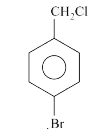Which one of the following gives white precipitate with AgNO3 ?



None of these
To determine which compound gives a white precipitate with AgNO₃, we need to analyze the options provided. The formation of a white precipitate indicates the presence of chloride ions (Cl⁻) that can react with silver nitrate (AgNO₃) to form silver chloride (AgCl), which is a white precipitate.
1. Understanding the Reaction:
- Silver nitrate (AgNO₃) reacts with halides (like Cl⁻) to form a precipitate. The reaction for chloride is:
Ag++Cl−→AgCl (s)
- AgCl is a white precipitate.
2. Identifying Alkyl Halides:
- We need to check which of the given options contains a chloride ion that can easily dissociate and react with AgNO₃.
3. Analyzing Each Option:
- Option A: If this contains a Cl atom directly attached to a benzene ring, it may have partial double bond character due to resonance, making it less likely to react with AgNO₃.
- Option B: Check if it contains a halide that is not Cl. If it contains Br or I, it will not give a white precipitate with AgNO₃.
- Option C: If this contains a CH₂Cl group (alkyl chloride), it is likely to dissociate easily and react with AgNO₃ to form AgCl.
- Option D: Similar to option B, check for the presence of other halides.
4. Conclusion:
- After analyzing the options, Option C is the most likely candidate to give a white precipitate with AgNO₃ because it contains a CH₂Cl group that can easily dissociate and react to form AgCl.
Final Answer:
Option C gives a white precipitate with AgNO₃.
- Silver nitrate (AgNO₃) reacts with halides (like Cl⁻) to form a precipitate. The reaction for chloride is:
Ag++Cl−→AgCl (s)
- AgCl is a white precipitate.
- We need to check which of the given options contains a chloride ion that can easily dissociate and react with AgNO₃.
- Option A: If this contains a Cl atom directly attached to a benzene ring, it may have partial double bond character due to resonance, making it less likely to react with AgNO₃.
- Option B: Check if it contains a halide that is not Cl. If it contains Br or I, it will not give a white precipitate with AgNO₃.
- Option C: If this contains a CH₂Cl group (alkyl chloride), it is likely to dissociate easily and react with AgNO₃ to form AgCl.
- Option D: Similar to option B, check for the presence of other halides.
- After analyzing the options, Option C is the most likely candidate to give a white precipitate with AgNO₃ because it contains a CH₂Cl group that can easily dissociate and react to form AgCl.
Option C gives a white precipitate with AgNO₃.
Topper's Solved these Questions
- INTRODUCTION TO ORGANIC CHEMISTRY BOOK - VMC MODULES ENGLISHCHAPTER - INTRODUCTION TO ORGANIC CHEMISTRY EXERCISE - LEVEL 2
49 Videos
- INTRODUCTION TO ORGANIC CHEMISTRY BOOK - VMC MODULES ENGLISHCHAPTER - INTRODUCTION TO ORGANIC CHEMISTRY EXERCISE - LEVEL 2 (Numerical value type )
15 Videos
- INTRODUCTION TO ORGANIC CHEMISTRY BOOK - VMC MODULES ENGLISHCHAPTER - INTRODUCTION TO ORGANIC CHEMISTRY EXERCISE - JEE ADVANCED ARCHIVE
81 Videos
- ICONIC EQUILIBRIUMBOOK - VMC MODULES ENGLISHCHAPTER - ICONIC EQUILIBRIUMEXERCISE - IMPECCABLE
50 Videos
- IONIC EQUILIBRIUMBOOK - VMC MODULES ENGLISHCHAPTER - IONIC EQUILIBRIUMEXERCISE - IN - CHAPTER EXERCISE - K
10 Videos
Similar Questions
Which one of the following will give a white precipitate with AgNO3 in aqueous medium ?
View SolutionWhich of the following reagents gives white precipitate with Hg(NO3)2 solution?
View SolutionWhich one of the following is likely to give a precipitate with AgNO3 solution ?
View SolutionWhich one of the following is likely to give a precipitate with AgNO3 solution ?
View SolutionWhich one of the following does not give white precipitate with acidified silver nitrate solution?
View SolutionWhich one of the following compounds will give white precipitate
with tollen's reagent ?
View SolutionWhich of the following does not give yellow precipitate with AgNO3 ?
View SolutionCu2+ ions give white precipitate with :
View SolutionWhich of the gives a white precipitate with a solution of AgNO3, a white precipitate with dil H2SO4 and a green flame test ?
View SolutionWhich of the following will not produce a precipitate with AgNO3 solution?
View Solution
